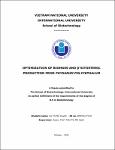| dc.description.abstract | Physarum polycephalum (slime mold) of the Physarales order is frequently observed in the
trophic stage as plasmodium. This species’s microplasmodium, which developed from the
plasmodium in submerged culture, was able to produce more biomass, and lipid than the
plasmodium. Physarum polycephalum is a potential source of valuable lipids, which mostly
consists of high triglycerides with significant amounts of essential unsaturated fatty acids.
Notably, beta-sitosterol was accidentally found in the microplasmodial biomass in prior study
conducted by our research group. Both the growth, lipid accumulation and beta-sitosterol
synthesis were reportedly influenced by medium composition and culture conditions. Thus,
the purposes of this study were to investigate the effects of carbon sources, mode of culture,
light and nutrient depletion on biomass, lipid and beta-sitosterol compound production.
Glucose was determined to be more effective than sugarcane powder regard to the influence
of carbon source. On the fifth day of a glucose-based microplasmodial culture P.
polycephalum, the biomass produced was 11.28 g/L and the lipid production was 1.377 g/L,
as opposed to 8.16 g/L and 0.7181 g/L for the culture based on sugarcane juice powder. The
maximum cell growth (16.54 g/L) and lipid production (1.64 g/L) were recorded in P.
polycephalum samples grown on glucose medium for 4 days in the dark before most of the
aqueous phase was removed and LED lamps were applied. These values were significantly
higher than in the control culture (totally in darkness). In compared to the control culture,
sugar juice powder culture with light exposed slightly improved biomass and lipid synthesis.
Though, the lipid content (percentage of lipid in one gram of dry biomass) seemed to be higher
under dark condition (8.15%) than in the presence of light (5.25%). β-sitosterol has been
found to be abundant in sugarcane broth medium when treated with light and nutrient
depletion, the compound accounted for up to 44% of total lipid concentration. In contrast, the
GC-MS analysis revealed that P. polycephalum considerably raised the amount of unsaturated
fatty acids, namely linoleic acid - omega 6 (38.2%) and oleic acid -omega 9 (30.1%), in
glucose culture with identical treatment.
This research results suggested that P. polycephalum microplasmodium is potential natural
source of unsaturated fatty acids and beta-sitosterol compound that would be used for
functional foods or dietary supplements | en_US |


